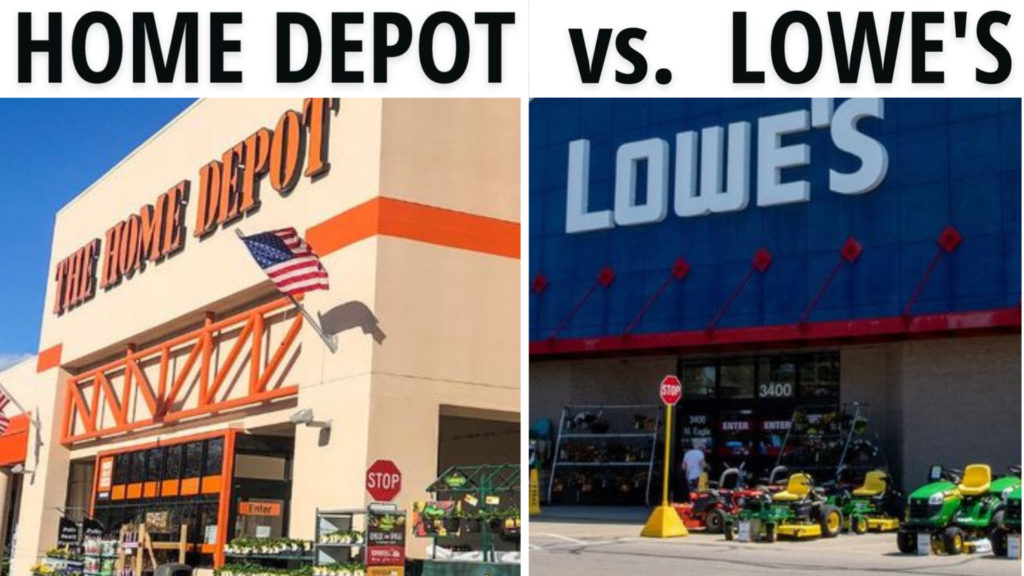The housing market has always been a significant business driver for home improvement giants like Lowe’s and Home Depot. However, recent changes in the market are presenting new challenges for these industry leaders.
Due to the recent spike in home prices and high mortgage rates, many homeowners lack sufficient funds to afford home improvements. Both businesses are feeling the pinch as rates continue to climb.
Fewer home purchases mean less demand for renovations, remodels, and upgrades, core parts of Lowe’s and Home Depot’s business models. The housing market downturn is not just a temporary hiccup; it indicates a broader economic shift that could impact these companies for years.
Are Lowe’s and Home Depot the Same?
At first glance, Lowe’s and Home Depot might seem like mirror images. Both companies offer extensive home improvement products, from lumber and tools to appliances and garden supplies. They cater to DIY enthusiasts, contractors, and homeowners looking to revamp their spaces.
However, despite their similarities, Lowe’s and Home Depot are different. They have various product offerings, target markets, and even store layouts. For instance, Home Depot attracts more professional contractors than Lowe’s, owing to its more comprehensive selection of tools and building materials.

Conversely, Lowe’s often appeals to homeowners and DIYers, focusing on customer service and aesthetically pleasing store designs. These peculiarities have allowed both companies to create niches in the competitive home improvement industry. However, as the housing market slows, Lowe’s and Home Depot must restrategize to maintain their unique value propositions.
ALSO READ: Home Depot Anticipates Decline in Sales as Consumer Caution Grows
Why Does Home Depot Outperform Lowe’s?
Regarding revenue and market share, Home Depot has consistently outperformed Lowe’s. This is due to many factors, the first of which is Home Depot’s focus on the professional contractor market.
Contractors tend to make larger purchases more frequently, driving higher sales for Home Depot. Home Depot’s focus on in-stock inventory and affordable rates has also helped it capture a larger market share.

The effectiveness of Home Depot’s distribution network and supply chain are additional factors in its success. Home Depot’s ability to keep shelves stocked with the products that customers need when they need them gives it a competitive edge over Lowe’s.
Also, Home Depot can provide a seamless shopping experience for customers, whether in-store or online, thanks to its investments in e-commerce and technology. This flexibility has been particularly significant since more people are shopping online, a trend that has grown since the outbreak.
Who Is Lowe’s Biggest Competitor?
Home Depot is, without a doubt, Lowe’s biggest competitor. The two businesses have been battling for supremacy in the home improvement market for many years.
However, the competitive landscape doesn’t end there. Lowe’s faces competition from companies like Menards, Ace Hardware, and even online giants like Amazon. Menards, especially, has been a regional rival in the Midwest, offering similar products at more affordable rates.

With its smaller neighborhood stores, Ace Hardware appeals to customers seeking convenience and personalized service. Meanwhile, Amazon poses a growing threat to Lowe’s and Home Depot as more people shop online for everything from power tools to household appliances.
To stay ahead of these competitors, Lowe’s must continue to innovate and find fresh ideas to draw and retain customers, especially as the housing market becomes more challenging.
Who Is Lowe’s Target Market?
Lowe’s is a one-stop shop catering to professional contractors and DIY homeowners. However, the company’s primary target market has traditionally been the average homeowner looking to take on home improvement projects.
This focus is reflected in the store’s layout, products, and marketing initiatives, which emphasize customer service and the ability to help customers confidently complete their projects.

Lowe’s also targets women more effectively than Home Depot, which has historically catered more to men and contractors. Lowe’s has successfully carved out an edge in the competitive home improvement market by offering products and services that appeal to female consumers, such as home décor and design consultations.
As the housing market continues to decline, Lowe’s may need to make more efforts to attract this demographic and explore new ways to appeal to different clientele.
ALSO READ: Demystifying the Current State of the US Housing Market
Home Depot vs. Lowe’s Revenue
When comparing Home Depot vs. Lowe’s revenue, it’s evident that Home Depot has the upper hand. Home Depot’s revenue has consistently outperformed Lowe’s in recent years, owing to its dominance in the professional contractor market.
Home Depot reported its first-quarter revenues of $36.4 billion, down from $37.2 billion in the same-store sales in the U.S. last year by a 3.2% difference. The brand’s earnings of $3.63 per share (down from $3.82 last year) did beat the analyst consensus, although they still fell short of Wall Street projections.

On the other hand, Lowe’s has seen steady growth but has struggled to close the gap with Home Depot. One reason is Lowe’s slower adoption of e-commerce, which has become increasingly important as more people shop online.
Lowe’s shared its numbers a week later, and they weren’t any better. Compared to the previous year, revenues dropped 4.4% to $21.4 billion, and earnings per share decreased from $3.78 to $3.07 this year. Nonetheless, the top and bottom lines did exceed analyst projections.
Investors often compare Lowe’s vs. Home Depot stock and revenue when deciding where to invest their money. Historically, Home Depot has been the stronger performer, consistently delivering shareholder returns.
As the housing market continues to slump, both companies will need to generate fresh ideas to drive revenue and maintain their competitive positions.
Home Depot’s “Pyramid” Strategy vs. Lowe’s Focus on Customer and Employee Engagement
Lowe’s and Home Depot appliances have significantly increased revenue for both companies. These big-ticket appliances, which range from washing machines to refrigerators, are essential for new homeowners and those remodeling their homes.
A contributing factor to Home Depot’s success is an approach that places priority on customers, employees, and shareholders in that order. This approach is called the “Home Depot Pyramid” approach and has built customer loyalty and delivered consistent shareholder returns.

Although Lowe’s places equal emphasis on employee engagement and customer satisfaction, both companies face the challenge of adjusting to a shifting housing market, which may necessitate reevaluating their strategies and making technological investments to stay competitive.
You Might Also Like:
How the NAR Settlement Affects Homebuyers and Sellers
This Small-Cap Fund Is Beating the Russell 2000: Here’s Why
WeRide, China’s Self-Driving Startup, Delays U.S. IPO as Deadline Approaches
Gasoline and Electric Cars: Comparing Their Lifespan Costs and the Importance of Location
Philadelphia Fed President Harker Calls for Federal Interest Rate Cut in September

